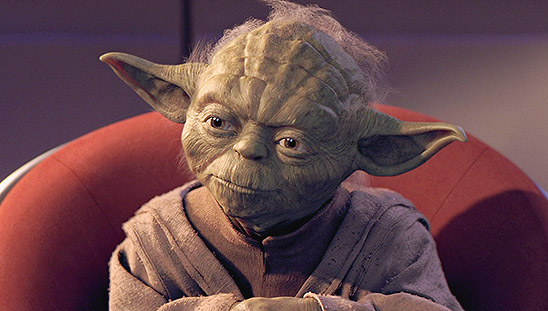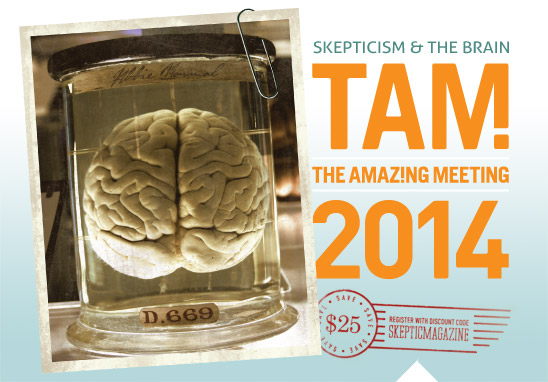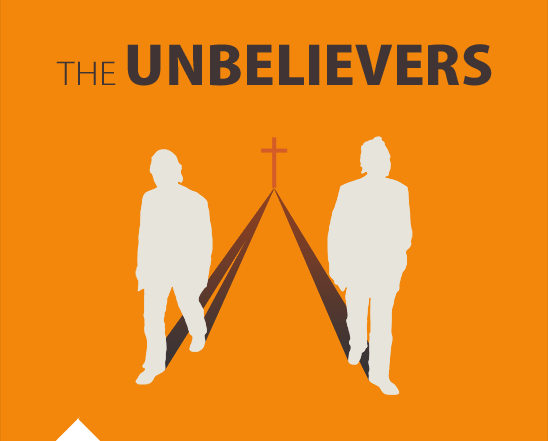In this week’s eSkeptic:
Join Us For The Amazing Meeting
South Point Casino, Las Vegas
July 10–13, 2014
How does cognitive science inform the project of skepticism? What brain sciences should you be skeptical about? Are brains hard-wired for belief in the unbelievable? Explore the science of the brain at The Amazing Meeting 2014: the world’s largest celebration of science and skepticism!
Our theme this year—Skepticism & The Brain—focusses on the cognitive and brain sciences and how they inform the project of skepticism. Keynote speakers include the acclaimed philosopher, cognitive scientist, and best selling author DANIEL DENNETT, Scientific American Editor-in-Chief MARIETTE DICHRISTINA, and MICHAEL SHERMER, Editor-in-Chief of Skeptic magazine. Other speakers include neurophilosopher Patricia Churchland, Australia’s Dr. Karl, Evolution & Human Behavior Editor-in-Chief Robert Kurzban, Brainwashed: The Seductive Appeal of Mindless Neuroscience authors Scott Lilienfeld and Sally Satel, M.D., influential memory researcher Elizabeth Loftus, clinical neurologist Steven Novella, M.D., immunologist Paul Offit, M.D., National Center for Science Education’s Eugenie Scott, psychologists and best selling authors Carol Tavris and Richard Wiseman, and many, many more!
This annual celebration of critical thinking is an unparalleled opportunity to make like-minded friends, enjoy some of the brightest minds on issues important to skeptics, and leave with tools for spreading a helpful and educational message to those who might be hurt by charlatans and unfounded belief. Join James Randi and over a thousand other like-minded folks for four days of fun, friendship, and critical thinking!
Enter “SKEPTICMAGAZINE” when registering and save $25.
Documentary Film Screening with Richard Dawkins: The Unbelievers
New York Times bestselling author Richard Dawkins will tour the United States in April to screen his new film, The Unbelievers, and answer audience questions. The evolutionary biologist is joined by internationally known physicist Lawrence Krauss, and at one stop by magician Penn Jillette of Penn & Teller. Filmmakers Gus Holwerda and Luke Holwerda of Black Chalk Productions will also appear and take questions. The film is a road trip documentary that follows Dawkins and Krauss as they make stops around the world, from Australia to New York, to speak out for reason and science. “One of the most remarkable things about making The Unbelievers,” said Gus Holwerda, “was to reveal the Richard Dawkins that you don’t see in public life. He can be a bulldog at the podium when it comes to defending science and reason, but in the film we see him for the person he is, extremely warm and personable.” Several celebrities appear in the film to support Dawkins and Krauss on their journey to promote reason and science, including Woody Allen, Stephen Hawking, Stephen Colbert, Cameron Diaz, Sarah Silverman, Bill Pullman, Werner Herzog, and Bill Maher. The movie ends with The Reason Rally: the largest atheist rally in history that took place in Washington DC in 2012.
Tour Dates
April 2, 2014, at 6:00 p.m.
The UC San Diego RIMAC
9500 Gilman Dr., La Jolla, CA
Order tickets
April 3, 2014, at 7:30 p.m.
The Cox Pavilion at the University of Nevada
4505 S Maryland Pkwy, Las Vegas, NV
Hosted by magician Penn Jillette of Penn & Teller
Order tickets
April 7, 2014, at 7:00 p.m.
Mershon Auditorium at the Ohio State University
1871 N. High Street, Columbus, OH
Order tickets
See the film and join the conversation in person with Richard Dawkins, Lawrence Krauss, and the filmmakers. For more information, visit RichardDawkins.net or UnbelieversMovie.com.
Follow The Unbelievers on Twitter @unbelieversfilm.

This is a screenshot of Yoda from the copyrighted Star Wars movie series (found on the Star Wars Wiki: Wookieepedia). It is used here under the fair use provision of United States copyright law to identify the character being discussed in the following article.
About this week’s eSkeptic
In this week’s eSkeptic, we present Andrew Harter’s case for the existence of Yoda, which appeared in Skeptic magazine issue 6.3 (1998).
Andrew Mayne (formerly Harter) is the star of A&E’s magic reality show Don’t Trust Andrew Mayne. His novel, Angel Killer, available in paperback from Bourbon Street Books (September 2014) was the fifth best-selling independent release in the United Kingdom in 2012. With the support of the James Randi Educational Foundation, Mayne started a program using magic to teach critical thinking skills in public schools, and his Wizard School segments aired nationwide on Public Television.
Share this article with friends online.
Subscribe | Donate | Watch Lectures | Shop
The Case for Yoda
by Andrew Harter
The recent coverage in Skeptic of ‘The God Question” (Skeptic 5.2) and the following article “The Case for God” (Skeptic 6.2) was quite interesting— yet a bit one sided. I feel that it unfairly neglected the debate over another supernatural entity—Yoda, the little green Jedi master who first appeared in The Empire Strikes Back. Cynics will immediately dismiss the suggestion that the existence of Yoda be seriously debated because he is clearly a fictional creation. However I propose that his apparent origin in the mind of George Lucas is actually further proof of his supernatural nature and all the more reason to bring the debate over Yoda to the skeptical forefront.
Yodists, those that believe in the existence of Yoda, and Atheiyodists, those that don’t (also sometimes called Trekkies), are divided into two very different world views. Yodists accept that the universe is guided by an all-encompassing energy that connects every living thing and every object. We’ll call this mystical force the “Force.” Yodists accept the idea that the Force works in strange and unimaginable ways. It guides us and controls us while giving us the power to choose between good and evil (the dark side of the Force.) Yoda is the greatest teacher there ever was of the ways of the Force. Atheiyodists deny Yoda because they are cruel, pessimistic people who have trouble accepting the wisdom of a short, green, big-eared entity that is so much more wise than they.
The first argument the Atheiyodists use in the debate over the existence of Yoda is that he is an imaginary character. They claim his origin as fictitious creation by director George Lucas, the alleged creator of all the characters in the Star Wars universe, is a widely accepted fact. However, what they are forgetting is that Yodists don’t dispute this. Yodists accept that George Lucas was the first person to “see” Yoda and to bring him to our attention. What the Atheiyodists are missing is that this was simply the way in which Yoda chose to reveal himself to us. By doing it in this manner he has given us a choice. We can merely believe that he is a puppet given life by the imagination of George Lucas and the voice of Frank Oz—or we can accept the greater truth that there always has been and always will be a Yoda who is all knowing and all powerful. Yoda used the cinematic experience to give us the opportunity to allow us the choice between Yodism and Atheiyodism.
While intense meditation has revealed to me all the proof I need, there are other examples that prove the case for Yoda. What would have happened if had Yoda appeared in any other movie than the Academy Award winning blockbuster The Empire Strikes Back? What if humans never developed the sense of sight or hearing? The Anthroyodic Principle shows us that if any of the conditions were just slightly off, there never could have been a Yoda for us to appreciate. The truth is that Yoda created these conditions so that we could learn from his wisdom in just the right atmosphere. The fact that in the movie he lives on a planet called Dagobah in a galaxy far, far away, is his way of telling us that even if conditions had been wildly different he still could have appeared to us—because he’s all powerful. Imagine if the principles of physics were slightly different and movie projectors were an impossibility? Or the physics was right but nobody ever bothered to invent a movie projector? What Atheiyodists would call “coincidences” a Yodist or any other reasonable person would admit was a miracle.
Atheiyodists are found of showing production stills and behind the scenes footage of The Empire Strikes Back and The Return Of The Jedi that show a Yoda puppet sitting lifelessly on a work bench or being animated by a person under a set. They say that this is proof that he is less than divine. What they haven’t let themselves appreciate is the fact that this is merely part of his plan. Yoda allows us to believe that he is merely a creation of Latex and foam rubber so that we can have the choice to believe. For those that want to live their lives spiritually bereft of the wisdom of Yoda, they can ignore the fact that on the screen the Latex and foam rubber transcend into something more spectacular. He becomes a living breathing being filled with the wisdom of the ages. This they cannot explain. Nor can the Atheiyodists tell us how it is that in a matter of a few months more people knew the name of Yoda and were touched by his wisdom than by any other spiritual figure in the history of mankind.
For further proof of Yoda I cite the near-tragic car accident that George Lucas was involved in when he was a young man. What kills thousands of other people every year left Lucas alive. He had a reputation for driving fast and recklessly, yet he survived it all. This incident, which reasonably could have been expected to take his life, in fact served as a catalyst for him to decide to devote his life to making movies. Yet, Yoda has a plan and we are all part of it. He chose to intervene so that Lucas could serve as his conduit.
I have meditated deeply and felt the way of the Force coursing through me. I have come to the understanding that Yoda is very real and a part of my life. Atheiyodists would do well to dispense with their prejudices and open themselves to the insights that come from within. Granted that these insights are very often flawed and that society never made any real advances until it began testing theories in the laboratory of the real world instead of the limited one in our heads. Obviously George Lucas’s survival can be looked upon as just the results of sheer probability. And yes, I admit that the Anthroyodic Principal is a rather silly argument and circular in nature because it takes for granted that we could no more argue our existence if we did not exist than a dead Christian Scientist can give testimony. But all of that doesn’t matter because when I close my eyes and reach my special place and ask the question “Yoda, are you there?” I hear a strange little voice that says “Yes, it is I that is here.” Yes, it is Yoda that is here. Away put your skepticism. ![]()
Marc Rayman, on Vimeo On Demand
NASA’s Dawn Mission to the Asteroid Belt
The ambitious Dawn mission, launched in September 2007, is one of NASA’s most remarkable ventures into the solar system. The spacecraft has recently completed a spectacular exploration of Vesta and is now traveling to Ceres; these were among the last uncharted worlds in the inner solar system prior to Dawn. Remnants from the time that planets were formed, Ceres and Vesta hold clues that will help scientists understand the dawn of the solar system. Dawn is the only spacecraft ever to orbit an object in the asteroid belt. Such a mission would be impossible without the use of ion propulsion, a technology that has mostly been in the domain of science fiction, but which was tested extensively on the Deep Space 1 mission, paving the way for Dawn. Dr. Marc Rayman, Dawn’s Chief Engineer and Mission Director at JPL, will describe the Dawn mission and its use of ion propulsion as well as its two exotic destinations. He will also share the excitement and profundity of controlling a spacecraft in deep space.
Rent this video for only $3.95
or explore the entire series.
INSTRUCTIONS: Click the button above, then click the RENT ONE button on the page that will open in your Internet browser. You will then be asked to login to your Vimeo account (or create a free account). Once you complete your purchase of the video rental, you will then be able to instantly stream the video to your computer, smartphone, or tablet, and watch it for the rental period. Videos play best on Vimeo when you allow the entire video to buffer before viewing it.














